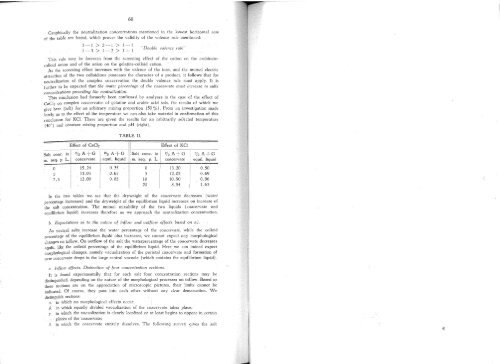V - DWC
V - DWC
V - DWC
Create successful ePaper yourself
Turn your PDF publications into a flip-book with our unique Google optimized e-Paper software.
"<br />
68<br />
Graphically the neutralization concentrati'ons mentioned in the lowest horizontal row<br />
of the table are foU'nd, which proves the validity of the valence ru1e mentioned:<br />
3-1>2~1>1-1<br />
1-3> 1-2> 1-1<br />
"Double valenee ntle"<br />
This ruk may be foreseen from the screening effect of the cation on the arabinatecolloid<br />
anion and of the anion on the gelatine-colloid cation.<br />
As the screening effect increases with the valence of the ions, and the mutual e1ectrie<br />
attraction of the two colloidions possesses the character of a product, it follows that for<br />
neutralization of the complex coacervation the double valenee rule must apply. It is<br />
further to be expected that the water pèrcentage of the coacerlJate must increase in salts<br />
concentrations preceding the neutralization.<br />
This conclusion had formerly been confirmed by analyses in the case of the effect of<br />
CaCl2 on complex coacervates of gelatine and arabic acid sols, the results of whieh we<br />
give here (left) for an arbitrary mixing proportion (50 0/0)' From an investigation made<br />
lately as to the effect of the temperature we can also take material in confirmation of this<br />
conclusion for KCI. There 'are given the resu.Jts for an arbitrarily selected temperature<br />
(40°) and cónstant mixÏ11g proportion and pH (right).<br />
~~-<br />
Effect of CaC!2<br />
TABLE Ir.<br />
I1<br />
Effect of KC!<br />
---- ---------------- --~----"<br />
Salt conc. i~l I<br />
%A G %A+G 11 Salt conc. in I %A+G %A+G<br />
m. aeq. p L. coacervate equi!. liquid 11 m. aeq. p. L.I coacervate equi!. Iiquid<br />
0 I 15.24 0.35 ii 0 I<br />
!:<br />
13.20 0.50<br />
I<br />
5<br />
13.05 0.65 5 12.02 0.69<br />
7.5 12.00 0.85 10 10.90 0.96<br />
20 8.84 1.63<br />
In the two tabjes we sec th at the dryweight of the coacervate decreases' (water<br />
percentage increa$es) and the dryweight of the equilibrium liquid increases on increase of<br />
the salt q:mcentration. Thc mutual mixabi1ity of the two Iiquids (coacervate and<br />
equilibrium Iiquid) increases therefore as we approach the neutralization concentration.<br />
b. Expectations as to the nature of inf/ow and outtlow ettects based on a).<br />
As neutral, salts, illcrease the water percentage of the coacervate, while the coIIoid<br />
pe~centage of the 'equilibrium Iiquid also increases, we cannot expeet any morphologieal<br />
changes on in flow. On outflow of the saltthe waterpercentage of the coacervate decreases<br />
agaih, Ilke the coIIoid percentage of the .equilibrium Iiquid. Here we can indeed expect<br />
morphOlogieaI changes, namely vacuolization of the parietal coacervate and formation of<br />
ncw coacervate drop~ in the large centra! vacuole (which contains the equilibrium liquid).<br />
c. Intlow effectB. Distinction of fOllt' COl1centration sections.<br />
It is found experimentally that for eachsa!t four concentration sections may be<br />
distinguished, depending on the nature of the morpho1.ogical processes on inflow. Based as<br />
these sections are on the appreciation of microscopie pictures, their limits cannot be<br />
indieated. Of course, they pass into each other without any clear demarcation. We<br />
distinguish sections:<br />
a. in which 110 morphological eHects oceur;<br />
~. in which equally divided vacuolization of the coacervate takes place;<br />
)'. in which the vacuolization is clearly localized or at least begins to appeal' \11 eertain<br />
places of thecoaçervate;<br />
iJ. in which the coacervate entirely dissolves. The following survey gives the salt

















